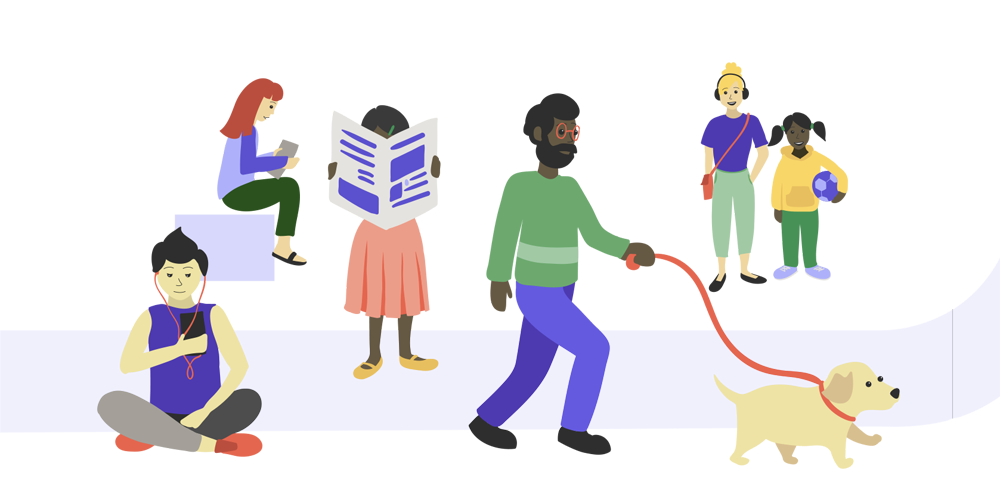Introduction
Juggling life through the uncertainty of the COVID-19 pandemic is challenging. But if you are someone living with autism and/or intellectual disability, or a family member caring for someone with autism and/or intellectual disability, this may be an especially stressful time. The loss of routine, connections with others and the shut down of services and places to go for support, may be causing additional stress and challenge. Changes in the way that we normally live may lead to isolation, and perhaps cause a setback in developmental gains. It may be very hard for caregivers without the supports and helpers that they received prior to the pandemic.
This Toolkit will provide some ideas about how to manage these changes.
Background: Talking About and Understanding COVID-19
Around the world, researchers are working to make sure that we have the best care and treatment to deal with COVID-19. For now, everyone is being asked to do their part by following public health measures (these are strategies that health officials recommend that we use to keep ourselves and others safe) which include physical distancing, frequent hand washing, wearing masks, and staying home as much as possible. That is why some services and places that you usually would be able to use or go to have been (and may still be) closed (like schools, doctor’s offices and recreation centres). Scientists have developed effective vaccinations and there is new information and updates about vaccine availability in Canada.
There are also many helpful tools available that explain each of these public health measures; some are designed specifically for individuals with autism and/or intellectual disability.
When talking about COVID-19, it’s important to find and share information that is from a reliable and reputable source.
Reputable information means that it is: trustworthy, highly regarded, credible, reliable, honest and dependable.
Tips
What to look for:
Information that is based on evidence and expertise from trustworthy and well-known sources such as a government agency, a university or a public health agency (for example, the Government of Canada, the Public Health Agency of Canada, the World Health Organization, or news organizations that use fact checking).
How to tell if the link or source is reputable?
Read what other sources say about the source you are reading
Get to know who are credible experts
Don’t believe everything you first read or click on the first link you find. Do more reading and make a decision about whether or not that source sounds credible to you.
Be cautious about:
Opinions or stories from sources that are not well known or who are known to publish false, misleading or controversial information.
Navigating Services During and After COVID-19
Many services (like extracurricular activities, treatment centres and supports/therapy) have been closed or services have been modified during the pandemic in efforts to contain the spread of the virus. Accessing services at this time can be frustrating and the lack of services can cause stress and a loss of connection and support. Federal and provincial/territorial governments have various programs in place, but you will need to continue to check on these programs as details are frequently changing. Check out the AIDE website for links to federal and provincial/ territorial government websites. Locally, stay in touch with your community organizations and news groups to find out what’s happening in your community.
Steps for Managing & Navigating Service Disruptions
Step 1. Identify your service needs and prioritize what is most important, and what can you do with less of:
- Learning/education
- Therapy
- Mental health support
- Recreation
- Respite
- Emotional support/counselling
- Financial information
- Social skills
- Peer engagement
- Physical fitness
- Other___________
Step 2. If you receive services from a provider(s) contact them to determine what is available or when services are expected to resume.
Step 3. Make a plan: Work with your current service provider(s) to develop a plan for service provision and support at home during service closures. Use your priority list to determine which services are most needed, and work with your service provider to develop a plan to access those services. You may need to replicate the services in another way. For example:
If in-person sessions are not available, service providers such as your family doctor or therapist may continue regular sessions through phone calls or virtual visits. Is this something that you would be interested in exploring?
Some organizations may offer “check-ins” with experienced facilitators or experts to provide support. If you are in school, the teacher and school support staff may assist to support your learning at home.
Check in with your local treatment centre to see what recreational or social connectivity activities they have available (either virtually or in other ways that follow social distancing requirements).
Working with Personal Support Workers (PSWs) & Home-Based Service Providers
If you have routinely had the support of PSWs or other support services in your home, these services may have been stopped or changed.
It is wise to have a safety plan when these services continue:
- Personal protective equipment is recommended
- Maintain frequent hand washing
- Alternatively, you may ask PSWs to provide services virtually or ask them to help out with non-direct services such as grocery shopping or picking up medication, for example. If you have funding, it would be wise to ensure that your funding covers any variations from typically covered services.
Step 4. Contact your local support systems (family members, neighbours, community organizations, etc.) to help out, if needed, with practical support such as grocery shopping. Family members such as grandparents or other volunteers may be willing to offer support such as virtual teaching.
Step 5. Seek out different ways to engage in your community. Maybe you can participate in virtual conferences, webinars or interactive online forums, observe video sessions; or participate in virtual chats with friends/family. All of these provide you with an opportunity to engage with others.
Step 6. Re-engaging with your community. Gauge your comfort level when returning to community services. Communities may be reopening but things are not really back to normal. Public health measures will be in place. You will most likely be expected to physically distance from others in a public place, your group gathering will be limited in size, and wearing a face covering will be required. This may cause feelings of worry or fear and extra reassurance or gradual re-engagement with your community may be needed to increase your comfort and confidence.
Step 7. Be prepared for possible ‘on again-off again’ service disruptions. Services may need to fully or partially stop at different times to contain the spread of the virus. As vaccines become widely available, it is hoped that community restrictions can be eased.
Step 8. Be sure that your name is on any lists for programs or services so that you are in queue for service start up.
Some Ideas...
There are many ways to supplement disrupted services that you may find helpful.
Using Technology & the Internet
The Internet offers unique ways to learn, connect, and shop for daily essentials. Some school boards and other organizations are helping people get access to a computer and the internet/Wi-Fi. Unique apps are also available to support and make life a bit easier. See the ‘Diversions’ section on this site for some ideas.
Here are just a few examples of how technology and the internet may be helpful when services are not fully available.
Learning & Fun
Audio books
On-line courses
On-line tutors
On-line classes (cooking, art, crafting, dance, comedy/improv, etc.)
On-line games
Podcasts
Day-to-Day Living
On-line grocery shopping & delivery
Pharmacy deliveries
Virtual Face-to-Face & Other Social Connecting Apps
ZOOM, FB messenger, Google Meets, Houseparty, Skype, Facebook Rooms, FaceTime, DUO, NextDoor, What’s Up, Webcasts and other social platforms
Recreation
Virtual tours of museums, historical places, zoos and aquariums
Physical Fitness
On-line fitness classes, yoga, meditation
Tips for Using the Internet Safely
Everyone is online more than usual during the COVID-19 pandemic which means that we are all more vulnerable to online challenges such as privacy breaches, phishing, hacking, scams and incorrect news.
Make sure that you know what is safe behaviour when you are online by adhering to the following advice:
✓ Never give personal information like your name, age or address to anyone that you don’t personally know
✓ Don’t give your financial information to anyone other than to a trusted source
✓ Be careful about requests for donations or money to unknown organizations that claim to be helping with COVID19 or other causes
✓ Learn how to determine what is real and what is pretend or fake information
Monitor and if needed, limit, the amount of time you are spending online. Try to balance your computer time with activities that involve you engaging with other activities and people.
What will Services Look like after the Pandemic?
As we have not experienced something like this before, it is difficult to know exactly how services will look after the COVID-19 pandemic. It is likely that continued public health measures such as regular health check-ins/screening and restricted group sizes, will frame how services will look in the foreseeable future.
You may find that you or your family have found some benefits from the adaptations made to services during the COVID-19 pandemic, and you may want to continue some of those services in this new way (possibly, along with the previous way that services were offered). What might be some changes that you would want to continue beyond the pandemic?
______________________________________________________________
______________________________________________________________
Resources
Below are Mental Health resources that may be of benefit to you, if you need support at this time. Also see the resources offered in this website (https://covid19.aidecanada.ca/).
Canadian Mental Health Association offers a variety of mental health services: www.cmha.ca
Kids Help Phone is a 24/7 country wide service that provides resources in both French and English: Tel: 1-800-668-6868, www.kidshelpphone.ca
Photo by Daniel Irwin on Unsplash


